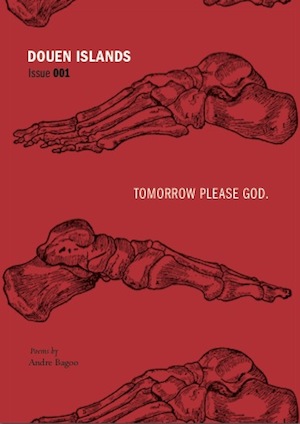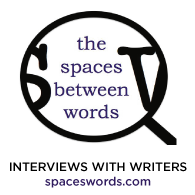douen, duende, douaine, done, dwen, duegne n A folklore character, the spirit of a child who died before baptism. Douens wear large hats, have backward-pointing feet, utter a soft hooting cry, and often lead children to wander off.
— Dictionary of the English/Creole of Trinidad and Tobago, ed. Lise Winer
 Announced (by no coincidence) on 31 October, All Hallows’ Eve, Douen Islands is a collaborative project by writer Andre Bagoo (author of the poetry collection Trick Vessels), graphic designer Kriston Chen, artists Rodell Warner and Brianna McCarthy, and musician Sharda Patasar. Its first manifestation is an e-book (downloadable here) of eleven poems by Bagoo, designed by Chen, and incorporating a series of brief texts by Warner (drawn from his Twitter account). Accompanying the e-book is Chen’s video adaptation of Bagoo’s poem “In Forest and Wild Skies”. Further online publications, videos, and live performances involving all five collaborators are in the works.
Announced (by no coincidence) on 31 October, All Hallows’ Eve, Douen Islands is a collaborative project by writer Andre Bagoo (author of the poetry collection Trick Vessels), graphic designer Kriston Chen, artists Rodell Warner and Brianna McCarthy, and musician Sharda Patasar. Its first manifestation is an e-book (downloadable here) of eleven poems by Bagoo, designed by Chen, and incorporating a series of brief texts by Warner (drawn from his Twitter account). Accompanying the e-book is Chen’s video adaptation of Bagoo’s poem “In Forest and Wild Skies”. Further online publications, videos, and live performances involving all five collaborators are in the works.
For many Trinidadians, douens — like other folklore characters — belong to another era. More amusing than sinister, they suggest a pre-electric time, rural life, tales to frighten children. But traditional folklore has also proved a rich resource for contemporary artists and writers. In the 1970s, artist Leroy Clarke produced a massive cycle of paintings, drawings, and poems called Douens, portraying a post-Independence society of “giddy and lost people.” A decade later, Peter Minshall’s 1988 mas band Jumbie released hordes of blank-faced spirits in the streets of Port of Spain, their empty, staring eyes suggesting a marauding hollowness all too apt in a time of political cynicism. More recently, poets James Christopher Aboud (Lagahoo Poems) and Fawzia Kane (Tantie Diablesse) and Trinidadian-Canadian novelist David Chariandy (Soucouyant) have re-imagined other supernatural folklore characters as metaphors for personal and cultural loss, the displacements of history, and the uneasiness of self-definition.
Douen Islands, whose creators describe the project as “a devious remixing of traditional Douen culture,” suggests that the old folklore stories and images remain relevant in the wired age — still offering insights into personal and collective fears. Though the poems’ voice is introspective and many of the references idiosyncratic, numerous co-options of nationalist rhetoric — such as Trinidad and Tobago’s national motto and “watchwords” — and the e-book’s (blood-)red-white-black colour scheme unsubtly indicate an allegorical intent. A prefatory note reads:
(a) Remove the straw hats. (b) Invite them inside. (c) Straighten their feet.
Invited in from the wilderness and dark, with supernatural deformities erased, the douen looks more and more like any Trinidadian of the post-Independence generation: mischievous but bewildered, uncertain of his social birthright, possibly hapless, possibly not helpless.
Soon after Douen Islands made its online debut, I asked its lead collaborators, Andre Bagoo and Kriston Chen, some questions about the project via email.
•
Nicholas Laughlin: Andre, which came first, the poems or the collaborative? Had you written the pieces before you started working with your colleagues, or did they emerge from the collaboration itself?
Andre Bagoo: I entered the collaboration with a loose idea of something I wanted to express. But it was during the collaboration that the ideas crystallised and words and forms came. I had been drawn to myths surrounding the undead, such as the zombie, which has clear roots in the Caribbean. I entered the collaboration wanting to write a curse poem in the manner of Ovid’s Ibis, aimed at Trinidad and Tobago and modelled after the 1968 film The Night of the Living Dead. Then Kriston specifically raised the figure of the douen one day over coffee. From that moment came Douen Islands. The poems flowed and flowed.
NL: How exactly did this group of creative collaborators form — who or what was the catalyst?
AB: Kriston reached out to me on Tumblr after he was assigned to do a layout for my poem “The Tourist” in [the art and design e-magazine] Draconian Switch. I was struck by the rigour of his practice as a graphic designer, as well as his appreciation of — and obvious talent for — language. We met, and he asked if there was anything else I had on which we could collaborate. I suggested a zine/e-book.
That was in March [2013]. Thereafter, we had several meetings and excursions over which we began formulating. It soon became clear that we also had our sights on including an element of performance in the project down the line, and wanted even more people involved. I reached out to sitarist Sharda Patasar, whom I had never met before. We reached out to Brianna McCarthy and to Rodell Warner, both of whom we already knew. We have more in store.
Kriston Chen: “The Tourist”, if I may interject, is a brilliant poem — heavy and light at the same time. Apparently there’s thirty more pages out there somewhere. I hope to revisit it at some point. My favourite line:
Silence: the wind is not certain.
What to make of this now?
I’m a fan of Andre’s work first. As a graphic designer, it begins with words. I put great faith in good writers. Andre mentions Sharda, Brianna, and Rodell as collaborators — they’re also good writers, in their own ways. There’s an attraction to that, and of course a good concept will go a long way.
NL: Does the idea of a group of collaborators change the way you work?
AB: You could say the process of writing is not changed by collaboration. The writer must still sit down in isolation and let the words come, or find the words and forms, invoking their own processes. This is really a personal exercise which, I imagine, differs from writer to writer.
However, it is clear to me that things done during the collaboration — comments over coffee, shared outings to see films, plays, concerts, and art shows, trips to scenic trails — all begin to inform, inspire, and move the writing. If we include the process of formulating ideas and being inspired within the process of writing, then perhaps a collaboration creates a greater wealth of discourse from which to draw at the moment when the words need to materialise.
In this way, each collaboration changes the way I write, because it changes me. W.H. Auden said of collaboration, “you can only do it with people whose basic ideas you share — each can then sort of excite the other. When a collaboration works, the two people concerned become a third person, who is different from either of them in isolation.”
KC: Well said. The same applies, I think, to designers. I saw an interview recently with the musician Sting, where he describes collaboration as “surrounding yourself with confidence.” When it comes to writing, Andre is prolific and brilliant. I don’t know if he sleeps, but I do know that the words always show up. The biggest question or concern is usually, “Where do we meet for coffee?” The unspoken confidence with those you collaborate with creates possibilities and moves the work along.
NL: Traditional folklore always draws on collective anxieties, hopes, questions of being. What can the figure of the douen, the spirit as lost child, say about (or say to) contemporary Trinidad and Tobago?
AB: Like most folklore and myth, the douen figure is at once simple yet complex. The douen is the undead: the child who dies after never being baptised and who haunts the forest thereafter. It has no face, its feet are backwards, so that hunters following its tracks go in the wrong direction. The nature of the douen alone transmits complexity: it engages questions of religion, of mortality and age, of physical deformity or difference. This makes it an ideal mirror for contemporary Trinidad and Tobago.
The douen tells us about the marginalised and the abandoned, and this is the area where I wanted to give voice to something. The douen is a nightmare figure of youth, and the story of a new generation has to be told, even if that story, in some respects, is an old one. Douen Islands is about growing up in a world while coming to terms with injustice in all its forms: violence and crime, racism, homophobia, religious bigotry, classism, stigmatisation. It is about moving from a place of blind rage to a place approaching knowledge.
The douen is both anodyne yet powerful — it embodies a subversive power relationship that is the key to so much. It is at first seen as monster but then made hero through love, and the real Bogey-man is left at large. I found using the folklore in this manner to be irresistible, because of how we, as Trinidadians, immediately recognise it, but also because of how it telegraphs and taps into wider collective anxieties, as you say, such as the fact that each of us is destined to die.
KC: During the course of the project, Andre had sent me an essay about folklore by Gerard Besson. It’s a great read. The douen is revealed as a vehicle for disciplining the parent, and not the child.
Duenn did not haunt children, “No, not at all, the Duenn is haunt the parent.”
“How you mean?”
“Well, she didn’t have time for the boy. She too busy wid she business. Then the night come, she ent see the boy, she gone outside, she calling calling, she standing up in the road under the street lamp, alone, everyone inside, she calling him, ‘Robie, Robie!’ She going mad with fear. The boy loose, he dead, the Duenn take him, somewhere. ‘Robie,’ she bawl, running inside, ‘Robie!’ She crying now, she can hardly breathe. ‘Robie! What you doing there? You eh hear me calling you, come here!’ She was so glad to see him that she cut his tail good.”
This intrigues me — the idea of well-behaved adults. “She was so glad to see him that she cut his tail good”: what a sentence. Lots of tension and vulnerability here. Why hasn’t the narrative around the douen reached further? Why are we still at straw hats and backwards feet?
NL: Do the poems draw on any particular literary inspirations or models, other than Ovid?
AB: They draw from a diverse range of materials. There are references to the love duet in Act II of Wagner’s Tristan and Isolde, John Donne’s “La Corona”, and Hamlet. There are also references to Anand Gandhi’s film Ship of Theseus and to Grizzly Bear’s pop single “Yet Again”. Several aesthetic forces were also operating in the background as I wrote, particularly Neval Chatelal’s rendition of “O Re Piya” from the Bollywood film Aaja Nachle, Bunji Garlin’s “Carnival Tabanca”, and the sitar music of Sharda Patasar. And I’ve also stolen from Trinidad and Tobago’s national anthem, the national watchwords, as well as common sayings in Trinidad and Tobago dialogue, which, when rendered in this context, hopefully take on new meanings.
NL: What about Leroy Clarke’s Douens?
AB: We did not have these in mind. Another collection of poems, however, was operating in the background: Lagahoo Poems, by James Aboud.
NL: Why publish the project as an e-book? How important is the online aspect?
AB: Perhaps because of the realities of the markets, we do not have many indigenous poetry book publishers. Most Caribbean writers are published by foreign publishers, which is not itself a bad thing, and which certainly has its place in relation to the important process of reaching an international audience. But I wonder if the Internet, while often seen to be in animus with publishing, is not also an opportunity for post-colonial countries like ours, to publish our own stories in our own ways, using cyberspace’s breath of tools and its reach.
I wanted to use the internet as a forum for sharing this particular work. I wanted to do something compelling online, in a way that we might not expect, given the subject matter, or given our idea of Caribbean poetry.
NL: Kriston, how did you approach the design elements of the project?
KC: Many of the design decisions for the e-book are in keeping with those of a traditional poetry book. The poems themselves are set in a serif typeface, called Requiem, ideal for reading but also a remnant of a long history of literature as both colonial and a printed medium — lettering from the Renaissance period is the basis of these particular letterforms.
I took a few liberties, however, to push this e-book into the twenty-first century. The use of illustration (found images, photographs, typography, etc) is dangerous ground, but used heavily. It imposes imagery into the reader’s mind. And like a film adaptation that tends to be not as good as the book itself, [images] can kill it for the poet’s readers. Designers-as-authors was another break in tradition. It went way beyond the covers and interiors: from conceptualisation to editing to copywriting. This, I think, helped create an e-book that feels consistent and complete.
As for the video, again the onus was to keep it literary — not let the images get in the way of the text. This was achieved through the use of fewer, simpler, but more powerful elements: captions, sound, moon, and vintage footage (from Carnival 1932). The viewer completes the piece by engaging with all elements, but primarily the text or captions.
In terms of references, much of my aesthetic and type treatment is influenced by contemporary designers such as Peter Mendelsund, John Gall, Jason Booher, Meg Wilson — much of the Knopf/Vintage book cover department. Several spreads reference John Gall’s beautiful and clever Nabokov series (published by Vintage in the US). There’s also reference to artist Barbara Kruger’s propaganda messages. The video contains references to Jean-Luc Godard’s film Une Femme est une femme (1961), and a more contemporary version, Gaspar Noé’s Enter the Void (2009).
•
“We hope to attract even more collaborators,” Bagoo writes. You can get in touch with the collaborative at douenislands@gmail.com.






{ 1 comment… read it below or add one }
It’s great to see Trini artists working together like a local Harlem Renaissance. Keep the collabos coming!